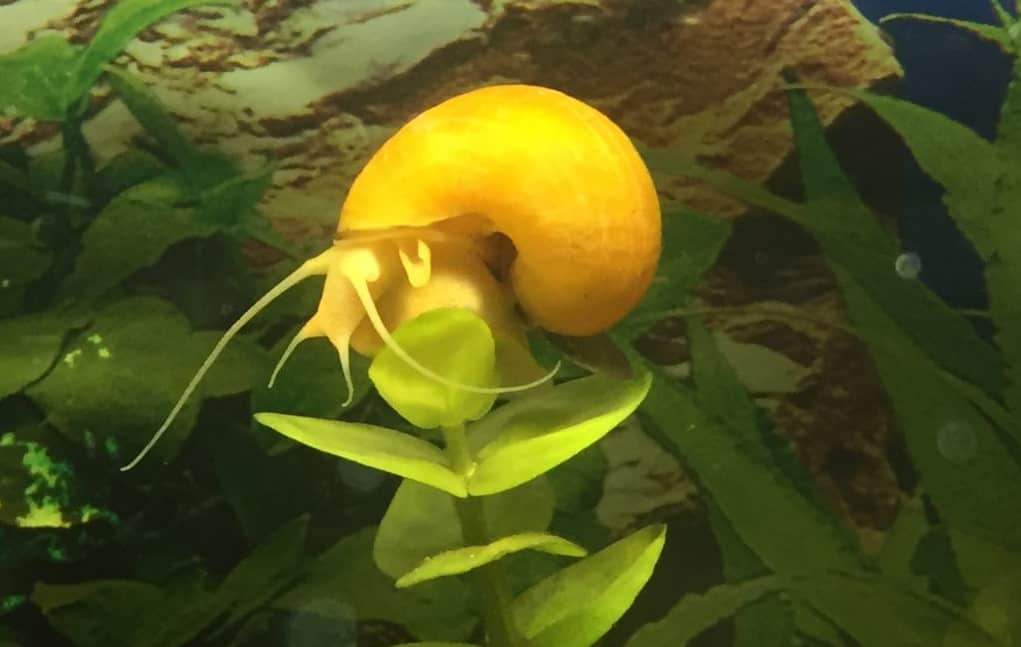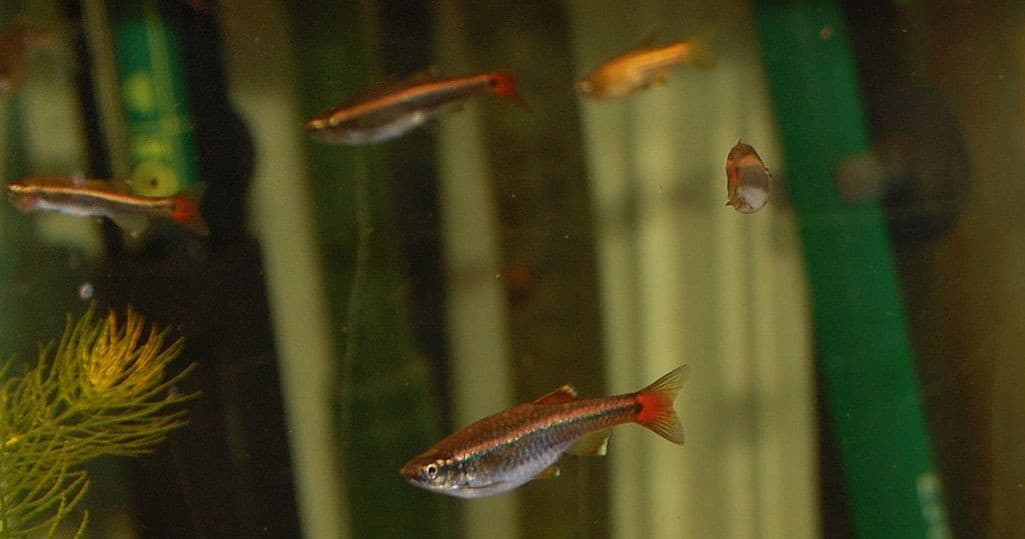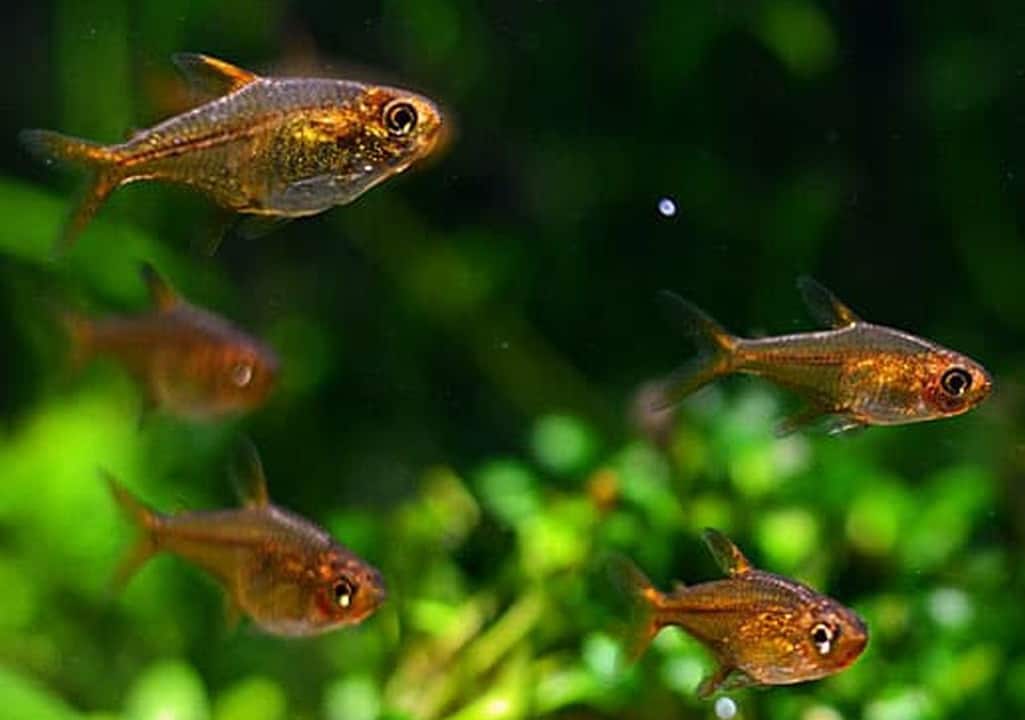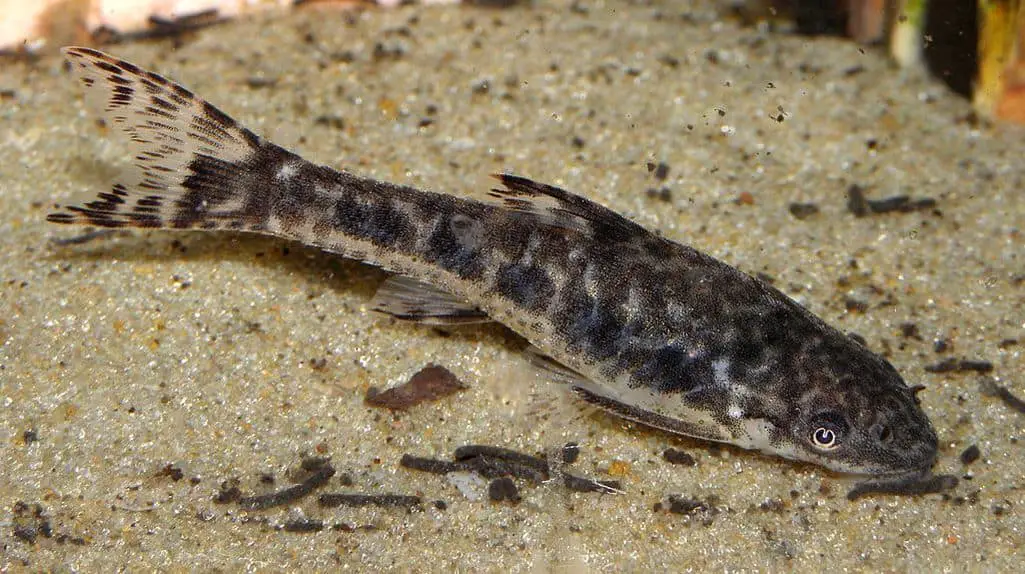11 Best Cherry Shrimp Tank Mates (With Pictures)
Cherry Shrimps are highly popular among fish keepers. With the right aquarium, cherry shrimps look very lively and fun.
That said, a cherry shrimp aquarium might be what you need to improve the look of your home or office.
Raising cherry shrimps isn’t easy. For instance, it’s better to raise cherry shrimps together with other aquatic animals in an aquarium.
Community aquariums allow cherry shrimps to thrive healthy and strong.
However, you can’t just pick any aquatic animal to live with your cherry shrimps. Cherry shrimps are picky about their friends. Pick the wrong one and they might die.
Let me help you choose the best buddies for your cherry shrimps. Here are the top 11 best cherry shrimp tank mates.
Table of Contents
Mystery (Apple) Snail

The mystery snail ( Pomacea bridgesii) is a type of snail that’s very popular among fish keepers.
It’s highly popular because it comes in various colors such as yellow, blue, purple, and black.
Most of the mystery snails in community tanks are those that originally come from Bolivia and Paraguay. There’s also a Chinese variety but I don’t recommend you to have it.
The Chinese variety is ugly looking and invasive. It’s becoming a problem in some parts of America right now.
The mystery snail prefers community tanks with lots of vegetation. Also, they prefer water conditions with a high ph level.
Mystery snails can breathe submerged and out of the water. Still, they don’t survive for long when breathing with their lungs.
The mystery snail is a herbivore. It eats algae. That said, the mystery snail is a good companion for your cherry shrimps because it helps to keep the community tank clean.
Mystery Snail Profile
- Other names: Spike-Topped apple snail
- Lifespan: one year
- Diet: Algae
- Preferred Water Condition: Acidic
- Minimum Tank Requirement: 5 Gallons
- Suitable Tank Mates: Cherry Shrimps, Ghost Shrimps, Tetras (Neon & Cardinal), and Killifish.
Corydoras Catfish

The Corydoras Catfish is a specie of armored catfish ( Callichthyidae ) that’s distributed in the fresh waters of South America.
It comes in a variety of natural color shades. However, the most common ones are brown, black, and white.
The Corydoras Catfish is an omnivore. It usually feeds on the bottom of the community tank eating algae and other small organic particles.
Don’t worry because Corydoras Catfish doesn’t feed on Cherry Shrimps. The Corydoras Catfish feeds on algae and detritus on the community tank most of the time.
The Corydoras Catfish loves to dwell on the bottom. Therefore, you should op to put at least 1-3 inches of sand, gravel, or other types of substrate.
Furthermore, the Corydoras Catfish loves to spend time near plants so consider putting a lot of these.
Corydoras Catfish Profile
- Other Names: Cory Catfish, Cory Fish
- Life Span: 5 Years
- Diet: Algae, Detritus, Bloodworms
- Preferred Water Condition: Neutral
- Minimum Tank Requirement: 10 Gallons
- Suitable Tank Mates: Cherry Shrimps, Tetras (Cardinal & Neon), Otocinclus Catfish, and Swordtails
Neon Tetra

The Neon Tetra (Paracheirodon innesi) is a small fish that originates from southeastern Colombia, eastern Peru, and western Brazil.
Neon Tetras are very popular among hobbyists because they’re colorful, very active, and easy to keep.
Just like Cory Fish, the Neon Tetra is an omnivore. It happily eats small flakes of vegetables and tiny bits of meat. You should alternate between these foods to ensure that Neon Tetra stays healthy.
You should observe meticulous tank care when keeping the Neon Tetra with Cherry Shrimps. Neon Tetras are prone to the so-called neon tetra disease.
A microsporidian parasite causes this disease which may be contracted from spoiled food and other animals in the tank.
Neon Tetras love to swim in schools. They make good additions to Cherry Shrimp community tanks because of their striking color and very active behavior.
Neon Tetra Profile
- Other Names: None
- Life Span: 8 Years
- Diet: Vegetable Flakes, and Dried Worms
- Preferred Water Condition: Acidic and Neutral
- Minimum Tank Requirement: 10 Gallons
- Suitable Tank Mates: Barbs, Rasboras, Cherry Shrimps, Guppies, and Loaches
White Cloud Mountain Minnow

The White Cloud Minnow (Tanichthys albonubes) is a small fish that originally comes from Baiyun Shan Mountain in Guangdong.
It’s a fish that comes in different colors depending on the variety.
Most White Cloud Minnows sold are captive bred. It’s because White Cloud Mountain Minnow population is very nil in China.
Recent discoveries revealed that Vietnam also has its own small White Cloud Mountain Minnow population.
The White Cloud Mountain Minnow isn’t picky about food. It eats commercial feeds, homemade fish feeds, and even insects that fall into the tank.
Even if it’s a voracious eater, the White Cloud Mountain Minnow is a peaceful fish and is one of the safest best cherry shrimp tank mates.
This fish isn’t picky about water acidity. However, it’s highly sensitive to water temperature.
Strive to make the water condition cool if you decide to keep White Cloud Mountain Minnow.
White Cloud Mountain Minnow Profile
- Other Names: Pin Yin Bai Yun Shan
- Life Span: 5-7 Years
- Diet: Small Insects, Commercial Fish Pellets, Worms
- Preferred Water Condition: Acidic or Neutral, Cold
- Minimum Tank Requirement: 12 Gallons
- Suitable Tank Mates: Cherry Shrimps, Discus, Angelfish, Mollies, Harlequin Rasboras
Harlequin Rasbora

The Harlequin Rasbora (Trigonostigma heteromorpha) originates from Malaysia, Singapore, Southern Thailand, and Sumatra.
It became popular among fishkeepers in the 1990s due to its striking color and fun shoaling behavior.
The signature black patch of the Harlequin Rasbora makes it extremely attractive. Its silver body with a slight hue of bright orange brings out the black pitch on its tail even more.
However, there are also Harlequin Rasboras that come in black, blue, and gold color tones.
Harlequin Rasbora is an omnivore. However, a diet consisting of worms and shrimps is crucial to keep its color.
Don’t worry because the Harlequin Rasbora doesn’t feed on Cherry Shrimps. Captive-bred Harlequin Rasboras only eat fish flakes.
The Harlequin Rasbora is more active when in a group. This is why you should consider raising many in a fish tank.
The Harlequin Rasbora doesn’t fair well when alone and might even die from stress.
Harlequin Rasbora Profile
- Other Names: Red Fish, Harlequin Fish, and Harlequin
- Life Span: 8 Years
- Diet: Fish Flakes made from dried worms or brined shrimps
- Preferred Water Condition: Soft and Acidic
- Minimum Tank Requirement: 10 Gallons with Very Spacious Set Up
- Suitable Tank Mates: Cherry Shrimps, Neon Tetras, Danios, Dwarf Gouramis, Cory Fish
Oto Catfish
The Oto Catfish originates from South America. This fish has 19 color varieties.
Nevertheless, the signature black spots are always present on the Oto Catfish regardless of the variety.
Algae is the favorite food of the Oto Catfish. It’s one of the best cherry shrimp tank mates for keeping the community tank clean.
Oto Catfish isn’t invasive. Furthermore, it doesn’t stress other aquatic animals in the community tank.
Oto Catfish love to feed together. This is one of the main reasons why they’re very efficient at removing algae that grow on the sides and bottom of the community tank.
Oto Catfish Profile
- Other Names: Otocinclus Catfish, Dwarf Suckers, Dwarf Oto
- Life Span: 5 Years
- Diet: Algae, Algae Wafers, Small Bits of Zucchini
- Preferred Water Condition: Neutral, Warm
- Minimum Tank Requirement: 10 Gallons
- Suitable Tank Mates: Cherry Shrimps, Cory Fish, Danios, Dwarf Gourami, Guppies, and Zebra Loaches.
Dwarf Rasboras

The Dwarf Rasboras (Boraras maculatus) is native to Sumatra, Thailand, and the Malay Peninsula. It was first described by Duncker in 1904.
This fish is ideal for a community tank due to its unique schooling behavior.
The bright ruby coloration of the Dwarf Rasboras is very striking. Pair this with adequate lighting and it will make the community tank very noticeable for visitors.
The color of the Dwarf Rasboras is a bit similar to Chili Rasboras. However, the Chili Rasboras has a deeper color than Dwarf Rasboras.
Dwarf Rasboras is a voracious carnivore. That said, you should feed it various meat-based fish foods to maintain its beautiful color.
Dwarf Rasboras Profile
- Other Names: Pygmy Rasbora, Spotted Rasbora, Dwarf Spotted Rasbora
- Life Span: 3 Years
- Diet: Pellets, Dried Artemia, Freezed Artemia, Micro Worms, and Fine Blood-Worms
- Preferred Water Condition: Acidic
- Minimum Tank Requirement: 5 Gallons
- Suitable Tank Mates: Cherry Shrimps, Mystery Snails, Gouramis, and Celestial Danios
Endler’s Livebearer

The Endler’s Livebearer (Poecilia Wingei) is a tropical fish that hails from the Paria Peninsula in Venezuela.
This fish was first raised in the 1970s. At present, it’s highly popular due to its striking colors.
Red, black, orange, and red – the Endler’s livebearer usually come in these colors. However, the orange and red varieties are very popular in community tanks.
The Endler’s Livebearer is an omnivore. While raising it, you should give this fish a diet of veggies and meats. A non-balanced diet might result in discoloration and disease.
Endler’s livebearer doesn’t swim in tight schools. This is why seasoned breeders recommend that you don’t raise a lot of these in community tanks.
Endler’s Livebearer Profile
- Other Names: Endler’s Guppy, Cumana Guppy, Endler
- Life Span: 2 Years
- Diet: Frozen Bloodworms, Brined Shrimps, Grindal Worms, Vegetable Fish Flakes
- Preferred Water Condition: Hard Water, Warm
- Minimum Tank Requirement: 20 Gallons
- Suitable Tank Mates: Cherry Shrimps, Cory Fish, Small Tetras, White Cloud Mountain Minnows, Honey Gourami, and GlassFish
Ember Tetra

The Ember Tetra (Hyphessobrycon amandae) originally dwelled in the freshwater of the Aragyauia river basin in Brazil. The Ember Tetra comes in bright red or bright orange color.
However, the bright orange ember tetra is more beautiful. It shines with a golden hue when raised in a community tank with adequate lighting.
Ember Tetra loves to swim in schools. Furthermore, it’s more active when swimming in highly planted community tanks.
Consider investing money for a lot of aquatic plants if you decide to raise this fish together with your Cherry Shrimps.
The Ember Tetra feeds on algae and tiny bits of meat. However, its diet should lean more towards meats like brined shrimps and worms to maintain its color.
Ember Tetra Profile
- Other Name: Fire Tetra
- Life Span: 5 Years
- Diet: Bloodworms, Daphnia, Brined Shrimps, Tubifex, and Micro Pellets
- Preferred Water Condition: Neutral, Warm
- Minimum Tank Requirement: 10 Gallons
- Suitable Tank Mates: Cherry Shrimps, Cory Fish, Danios, and Apistogramma
Betta Fish

The Betta Fish (Betta Splendens) originates from Thailand. Specifically, Chao Phraya and Mekong.
This fish is very colorful and has a unique tail. As a result, it’s one of the best cherry shrimp tank mates on this list.
Raising Betta Fish isn’t for beginners. Proper experience in fish keeping is required for taking care of this fish.
You have to be very familiar with its food, habitat, and behavior.
Betta Fish gets lonely easily. This is why it’s best if you keep 2 or 3 with your Cherry Shrimps.
Furthermore, there should be lots of plants and other tank ornaments for the Betta Fish to explore.
The Betta Fish is carnivorous. It loves to eat small organisms in the aquarium. That said, try to separate baby Cherry Shrimps from the community tank so that the Betta Fish won’t eat them.
Betta Fish Profile
- Other Names: Siamese Fighting Fish
- Life Span: 5 Years
- Diet: Bloodworms, Daphnia, Brine Shrimp, and other high protein treats
- Preferred Water Condition: Neutral, Warm (You Can Use Tap Water)
- Minimum Tank Requirement: 3 Gallons
- Suitable Tank Mates: Cherry Shrimps, Kuhli Loaches, Ember Tetras, Malaysian Trumpet Snails, and Harlequin Rasboras
Ghost Shrimp

The Ghost Shrimp (Palaemonetes paludosus) hails from North America. Unlike Cherry shrimps, the ghost shrimp has a plain white color.
It’s not very striking in normal community tanks. However, Ghost Shrimp stands out if you’re willing to invest in lighting.
The Ghost Shrimp loves to move around the community tank to look for bits of food and other organic particles. It performs well in keeping algae away.
Due to this, don’t mix Ghost Shrimps with fishes that rely on algae for food.
Ghost Shrimp Profile
- Other Names: Grass Shrimp, Glass Shrimp, and American Glass Shrimp
- Life Span: 1 Year
- Diet: Dead Plant (roots and leaves), Detritus, and Algae
- Preferred Water Condition: Slightly Acidic
- Minimum Tank Requirement: 5 Gallons
- Suitable Tank Mates: Cherry Shrimps, Zebra Loaches, Kuhli Loaches, and Cherry Barbs
Essentials To Making A Cherry Shrimp Community Tank
Now that you know the best cherry shrimp tank mates, I’m sure that your itching to make a cherry shrimp community tank.
However, it’s not time yet. Familiarize these tips first before making one.
Recommended Size For Community Tank
The size of the community tank depends on how Cherry shrimps and other aquatic animals you’ll keep.
A general rule of thumb is that you start with a community tank that can contain 25-35 gallons of water.
Furthermore, the community tank should be very wide. You’ll need adequate space to allow for plants, devices, and other accessories.
Be Familiar With Water Compatibility
Familiarize water compatibility if you’re planning to keep Cherry Shrimps with two or more aquatic animals.
For example, it’s not a good idea to add Cory Fish and Mystery snail to Cherry Shrimp community tank because the latter likes acidic water while the former likes neutral water.
In contrast, it’s good to keep Mystery Snail and Neon Tetra with Cherry Shrimps because both love acidic water.
Don’t Clean The Community Tank So Much
Cherry Shrimp community tanks need to be a bit dirty. It’s because Cherry Shrimps love to feed on algae and detritus. Avoid too much cleaning because it’s bad for the Cherry Shrimps.
Learn To Separate Baby Cherry Shrimps From The Community Tank
This is very important if you’re raising Cherry Shrimps with fishes like the Betta Fish. Some Cherry Shrimps Fishtank mates love to eat small Cherry Shrimps. Consider separating them from the community tank so that they won’t get eaten.
Follow this tip so that you won’t have to buy Cherry Shrimps again and again.
Don’t Forget The Basic Requirements For Cherry Shrimp Community Tank
Here are some of the basic things that you need for a Cherry Shrimp Community Tank:
- Aquatic Plants – for fishes
- Ornaments- for fishes
- Substrate (either gravel or rock)- for the fishes, snails, and Cherry Shrimps
- Lighting – for raising Ghost Shrimps or fishes with Cherry Shrimps
- Ph monitor- for getting in touch with tank’s acidity
Conclusion
Cherry Shrimps are already attractive on their own. However, they’re more eye-catching when raised with other aquatic animals in a community tank.
Having a Cherry Shrimp community tank will allow you to see the natural behavior of Cherry Shrimps in the wild. It’s because the community tank will emulate the natural habitat of Cherry Shrimps.
The same also goes for fishes that live with Cherry Shrimps. The tank mates that I listed here are more active and fun to watch when raised in a Cherry Shrimp community tank.
Making a Cherry Shrimp community tank isn’t difficult. However, you should consider following the tips that I mentioned to avoid drawbacks.
To end, a Cherry Shrimp community tank might be what you need to improve the look of your office or house.
11 Best Ghost Shrimp Tank Mates (With Pictures)





